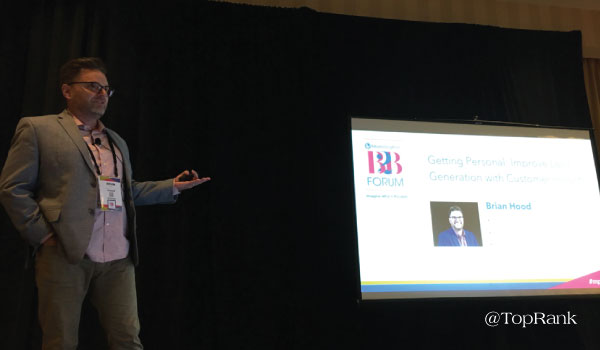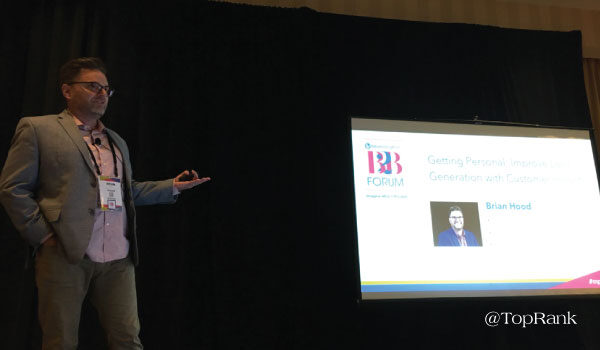
Here’s something you might already know about Intuit: The leading financial software company has been around for 35 years, buoyed by its primary software offerings, TurboTax and QuickBooks.
Here’s something you might not know (at least it was news to me): While Intuit does market to consumers, B2B customers comprise a large portion of the company’s base – its ProConnect division sells products to tax and accounting professionals, while Intuit, in general, is reliant on such pros to recommend TurboTax and QuickBooks to their own clients.
And on this B2B front, Intuit was facing a challenge: Leads had been flat for five years. Despite extremely high product awareness (I doubt anyone reading this hasn’t heard of those two main products) and strong tax firm industry retention rates around 90%, Intuit simply wasn’t bringing in new business at the desired rate.
To rejuvenate its lead generation, the company completely refreshed its strategy last year with an experimental approach driven by empathy and customer insights. Intuit’s Digital Director, Brian Hood, detailed their story during an eye-opening session full of practical takeaways at MarketingProfs B2B Forum last Thursday afternoon.
A New Spin on Customer Observation
When digital marketers think about customer insight, we usually think in terms of harnessing data and deriving useful conclusions. This is, of course, an important aspect. But Brian and his team at Intuit wanted to get a closer view. While their brand name might be defined in the dictionary as “to understand or work out by instinct,” they weren’t satisfied to rely on their gut.
Customer empathy is something Brian values immensely in his job. That was instantly clear. And speaking of definitions, I really like the one he shared for empathy: “Having such a strong understanding that it’s hard to tell the line between us and our customers.”
Customer empathy is having such a strong understanding that it’s hard to tell the line between us and our customers. @bw_hood Share on XAny marketer should aspire to this level of empathy, but it is not easily attained. Data and conversations with the sales team are certainly key pieces of the puzzle, but the team at Intuit sought a more direct perspective. So they decided to observe their prospects and customers – choosing 20 and connecting with each for an hour, via video or in-person.
One thing Brian has come to notice is that leading questions are problematic; either intentionally or subconsciously, people will often tell you what they think you want to hear. So his team made sure to be vague in direction, to obtain genuine insight.
“We asked, ‘Imagine you you were looking for a new bank. Here’s a computer. How would you start looking?’ ” he says. And a revelation quickly came to light: “What they say and what they do are very different.”
One unexpected finding: Many of these individuals went to the question-and-answer website Quora as a first step. “Our data never would have told us that was the No. 1 place they were going to do research,” Brian says.
With this knowledge about audience preferences in hand, Intuit’s marketing team was able to make some strategic adjustments, committing more dollars to paid media testing. Through these efforts, they saw a 15% growth in absolute leads.
“If you have flat leads, go talk to people,” Brian urges. “Find out what they’re doing and see if you can find some new insights.”
Innovation through Smart Testing
If you want to truly innovate for your customers, you can’t simply ask them what they want, because their imagination is inherently limited by existing solutions and capabilities. To illustrate this, Brian points to a classic example: Before the invention of the automobile, when consumers wanted to get to their destinations more quickly, they could only ask for a faster horse.
His team stays nimble and creative by following a broad-then-narrow testing model. “Start with what’s possible, then narrow down,” he advises. By developing empathetic customer insights, then using them as the basis for testing new techniques and rapidly iterating, Intuit maintains an innovative focus with its marketing strategy. But they offset the risks by committing only 5-10% of working capital to these types of tests.
“New experiments might fail, and probably will fail,” Brian acknowledges. But fear of failure can be a major detriment to meaningful progress.
He cited another use case where his team was feeling pressure to increase close rates and boost funnel conversion, and through this model, settled on a high-effort email and direct mail campaign. It wouldn’t have been their first choice, given the cost, but the experiment paid off as they hit their goals.
Insight through Empathy
“Make sure your marketing teams are out with your prospects and customers,” Brian urges. “Make sure that you use deep observation to understand how your products are actually helping them.”
Make sure your marketing teams are out with your prospects and customers. Make sure that you use deep observation to understand how your products are actually helping them. @bw_hood Share on XGranted, it’s not feasible for every company to set up the same types of investigative customer interfaces as Intuit does, but it’s always worth thinking about how you can better combine direct observation with data, surveys, social monitoring, and other methods to gain a full understanding of the audience you serve.
Until it becomes hard to see the line between you and your customers, there’s always more work to be done.



